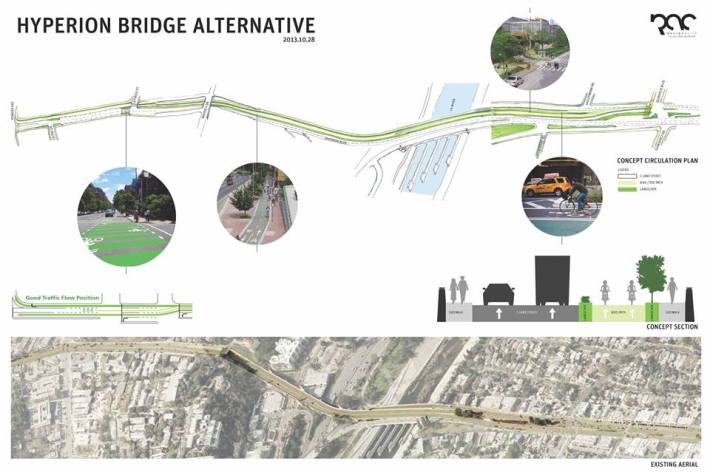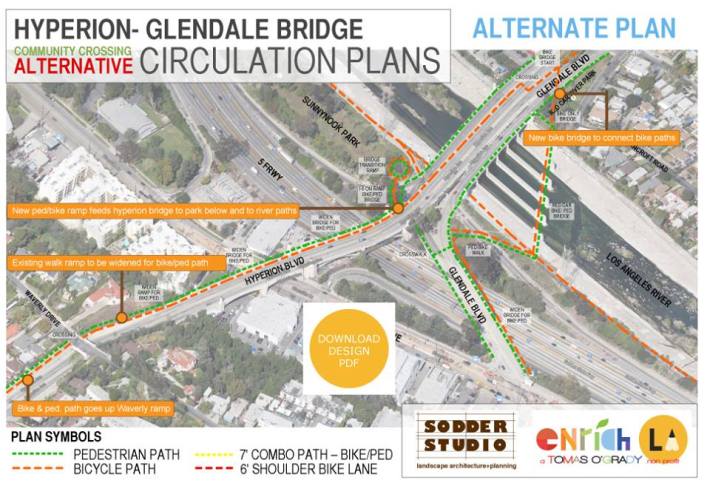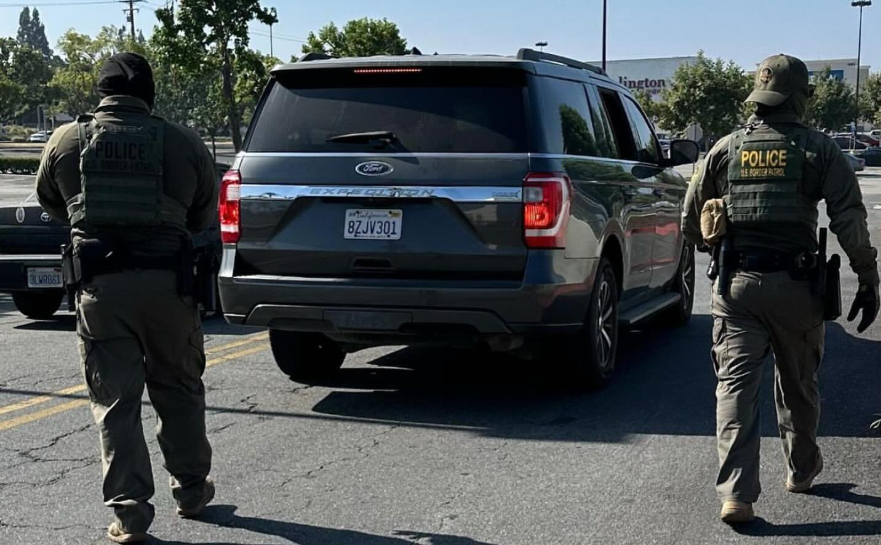
If you were keeping score at home, something which would be impossible because of our failed attempt at Live Streaming, it was a blowout. Nearly fifty speakers took to the podium. Four of them spoke in favor of the current design. The rest made the case for a more Livable design, lower speeds, and better access for bicyclists and pedestrians.
After nine years of comment and design, the Hyperion Glendale Seismic Retrofit plan had its first official public hearing last night. The main purpose of the project is to retrofit the bridge so it can withstand a major earthquake. However, during the retrofit, other work will be done to increase safety on the bridge. The current plan calls for tiny sidewalks, a gutter bike lane, four mixed-use 11-foot travel lanes and a 2-foot divider with two more feet of buffer in the middle of the road. The bridge is in the city's 2010 Bike Plan, and advocates were surprised and incensed to find the bridge wouldn't have bike lanes.
The alarm spread well outside of the bicycle community. River advocates, pedestrian safety advocates, neighborhood councils, Assembly Member Mike Gatto, and Glendale Council Member Laura Friedman all got involved, asking for a safer bridge for all road users.
Those that spoke up last night for the current project did so because they believe a seismic retrofit is needed as quickly as possible and that a center divider is needed for safety to keep cars from colliding with each other. All were Atwater residents who have worked on the project for nearly a decade. None are what you would call NIMBY or anti-bicycle. They just want the project completed.
But last night wasn't about keeping score. It wasn't just about bicycles. Last night was about communities, people and safety.
The Livable Streets stars were out. Eric Bruins with the Los Angeles County Bicycle Coalition crunched the crash data to show slower speeds would reduce crashes. Occidental College Professor Mark Vallianatos drew the link between wider lanes and faster vehicle traffic. Don "Roadblock" Ward argued that an LADOT engineer's claims that the average speed on the bridge is thirty-seven miles an hour was not what the public had been told at previous meetings. L.A. Walks founder Deborah Murphy delivered such powerful testimony that Urban Homestead co-author Erik Knutzen followed her basically said 'Murphy is right' and left the podium.
The night even featured an appearance by Bobby Gadda, the original Chair of the Steering Committee for CicLAvia, who had biked down from San Francisco.
"I just biked 500 miles from San Francisco...but the scariest part happened about an hour ago coming across the Hyperion Bridge downward spiral death zone,” Gadda testified. “I heartily encourage anyone who designs this bridge to ride across it on a bike. Put on a safety vest. You probably won’t die.”
Each speech was followed by applause.
But the night wasn't about the star testimony or applause. Last night was about communities, people, and safety. Everyday residents testified that they wanted a way to walk between Atwater and Silver Lake. They didn't want the bridge to be a barrier only able to be safely traversed surrounded by metal. They wanted change.
Tomas O'Grady, a one-time political opponent of Council Member Tom LaBonge and founder of Enrich L.A., brings his own design for a road diet, but more persuasive than the impressive rendering was his call for a bridge that brings together the communities of Atwater and Silver Lake because that's what makes the most sense for his children, now teenagers, and his family.
Similar comments were made by Melissa Casey, Kelly Thompson and Jenny Chamberlain. Each of the three mothers had a similar story, with a different twist. Casey told of how not just her children, but her mother-in law are made prisoners of a bridge they are scared to cross, Thompson of how she is scared every day her husband bikes to work and Chamberlain recounted how her children wanted to bike a quarter mile across the bridge when they were five, but she still won't let them walk or bike across it today.
Marshall High School student Andres Miyares crosses Hyperion every day on his way to school on his bicycle. Miyares, a resident of Highland Park, finds the commute to be a harrowing one.
“It’s not a fun experience. There’s this one turn where cars are hugging the corner and you just hope you don’t get hit. I’ve feared for my life at least ten times," he testified. "I don't want to die one day just going to school."
Another speaker, who went just by Adam, is still alive following a harrowing bicycle crash that left him hospitalized.
"In 2007, I was nearly killed on this bridge," he began before pleading with the city to find a way to slow down traffic on the bridge. "I’m just finding out about this (the redesign), so I can’t come in with all this technical information, but I know people go too fast on this bridge. But I know that four lanes is too many.”
Following Adam's emotional testimony, his friend Mark Marren continued the story, telling of how he and Adam left work at the same time one evening in 2007, but Adam didn't get home for six months. Amazingly, just days before a crash with a speeding car nearly took Adam's life, he witnessed Bill Winguard, a pedestrian, get struck in the same area. Further driving the point home, Marrnen's ex-wife had been hit in roughly the same area.
"I’ve gone to County and seen my friends lay there because of that bridge. I don’t want to see that again," Marren concluded.
Before the public testimony, representatives from the Bureau of Engineering presented a new rendering for the bridge design. The new design showed the crash walls still in place, but also reduced the width of the mixed-use travel lanes from the original design to make space for a three foot bicycle lane. While the plan shows that the project engineers are thinking outside of the original box, there are still problems with the plan. It still has tiny sidewalks and three foot "gutter" bike lanes may actually do more harm than good.
"Three feet is too narrow," testified Jeff Jacobberger, a member of the city's Bicycle Advisory Committee. "Bicyclists will have to take the lane. Drivers will think, 'There is a bike lane.' It will cause road rage."
The lowlight of the evening came when an LADOT Senior Engineer was called on to give background on the project. The engineer was unable to answer basic questions about the design, including what speed the new design was rated for. The engineer twice wistfully put it that the bridge traffic would "be lucky" if it could be rated for 35 miles per hour, but 55 miles per hour was beyond imagination. The consultant who once said the new lanes would be rated for 55 miles per hour was nowhere to be seen.
As a test, I drove across the Hyperion Bridge last night at about 4 pm. Going west, my speed averaged about 52 miles per hour. Going east, it was roughly the same. In both cases, I was in the left hand lane, driving with the flow of traffic.
I wasn't passing anyone.
After the engineer testified that the median speed on the bridge was "37 or 38 miles per hour," Michelle Mowery took over answering questions on behalf of the Department. The Senior Bicycle Coordinator was doing some triage by keeping the engineer from sounding any more separated from reality. She couldn't necessarily give better answers than her colleague, she just did so without sounding so enthusiastic about fast-moving cars. Mowery couldn't explain what data is used to justify the center median, usually used to prevent highway crashes, because the Department is still analyzing the crash data.
Towards the end of the hearing, Marino Pascal half-joked that the bridge project was right "At Ground Zero for bicycles," noting the history of bike culture in Silver Lake and Echo Park. While that is doubtlessly true, and many of the over 150 people in the audience were bicycle advocates, last night wasn't just about bikes.







